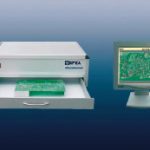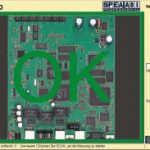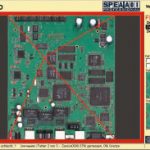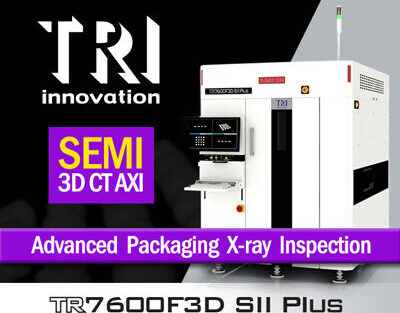AOI systems can be used for the quality assurance of board assemblies after stencil printing to control the paste, or after placement to verify component locations, and following soldering to inspect the solder joints. Coplanarity flaws, open pins and short circuits are reliably detected. In addition, also missing, displaced and loose parts are recognized as well as incorrectly assembled or components with reversed polarity.
Maren Witt, SPEA
Usually for the optical inspection, several cameras are used to observe an electronic assembly from different angles. Then, by image processing and analysis, an image of the board area will be generated which is finally compared to a master or reference pattern that the system has generated or learned, respectively, before.
Just recently, SPEA has launched an AOI system based on scanning technology. From the economical side, it’s an interesting choice. Scanning systems have only been available for a short time. Since their introduction, they evolved quickly from prototype stage to advanced systems being used on the shop floor. Currently, these systems feature the same high quality as 3D gear, and in the future, scanning systems will become the standard for optical inspection in production. They will probably gain more importance, steadily increasing the number of installed systems and finally even force out camera-based equipment in some application areas. Not only technical advantages play a crucial role in this trend, but also the substantially lower investment and cost of ownership.
Up to now, in most cases systems working with several cameras have been used. They illuminate the board from various angles and then generate an image (normally gray-scale based). An immense programming effort is necessary to determine the optimum settings for the individual cameras. In most cases, this prevents an easy and quick changeover from one board type to the other. The inspection speed depends to a great extent on the number of components to be verified and the camera travel courses resulting from that. Camera movements require some time so that inspection is relatively a time-consuming task – in spite of optimized travel courses and maximized acceleration.
Imaging sensor line with RGB filter
The missing color evaluation is a disadvantage of inspection based on gray-scale images. The conversion to shades of gray leads to situations in which colors with the contrast and saturation can no longer be sufficiently distinguished from each other. Defects then are either not recognized or incorrectly interpreted, meaning that a high rate of errors and consequently false calls has to be taken into account. On the other hand, scanning systems provide color images, containing considerably more information than gray-scale pics. As a result, defects will be recognized with high re-liability, while false calls are extremely minimized.
The SPEA system operates with a scanning unit featuring a CCD sensor line with RGB color fil-ter for imaging. Thus, the three additive color channels are available for recognition and evaluation. The equipment can reliably recognize a wide range of objects with colors of similar saturation, but also id-entical parts with color variations due to dif-ferent manufacturers or batches, respectively. This feature can be used since the color channels can be set individually or even be faded out. A very large working area (DIN A3 format) and the automated zero calibration are just two of many special features. The scanning unit is mounted in the specially encapsulated housing for industrial applications, and is protected against any dirt ingress. Since the instrument is equipped with a modern industrial scanner, the technology is up-to-date, and due to its small dimensions, the amount of space needed is reduced to a minimum.
Intelligent strategy
The instrument is used for the optical quality control of SMT as well as chip assemblies, and for adhesives, paste print and solder joints. Component inspection can either be performed before or after the soldering process. A reliable recognition of incorrectly assembled parts is ensured since image capturing and evaluation are performed using RGB colors.
On board assemblies, the system checks for integrity and component positions. In combination with SPEA’s 4040 flying probe, it is part of the IPCS (intelligent process control strategy) concept for performing selective tests. Another field of application is inspection when the contact areas of boards are completely covered with solder and electrical test is impossible. Due to its approach, the system is ideal for the monitoring of the production process. Compared to similar equipment, the capital expenditure is approximately 50% lower.
Inspection program created during operation
The instrument is provided with easy-to-use system software. During paste inspection, various Gerber formats can be imported to permit inspection program generation. Based on this data and after learning from a reference, the verification program is automatically generated quickly. Paste inspection comprises all current surfaces and their treatments such as the board copper pattern or hot-air leveling, etc.
Based on the CAD data, an inspection program is automatically generated during component verification. The required datasets are extracted from the SPEA board data description file. The program file is generated using the library available in the AOI software. It contains information related to the code number of components as well as inspection algorithms. It goes without saying that we may also use component assembly data.
Speed and resolution
Since an entire assemb-ly is scanned in oneprocess, it takes only a couple of secondsto check even large boards. In contrast to other scanning systems, the speed does not depend on the type and number of components to be tested, but is only determined by the board size and optical resolution. For a board with 165 x 185mm and an image resolution of 450dpi, inspection takes only 12s. If a resolution of 600dpi is used, it takes only 19s. On one hand, this high speed is a result from the scanning throughput, and on the other hand, it derives from the evaluation algorithms that are based on a pixel-by-pixel comparison.
While the false-call rate is extremely low (due to the use of RGB color), defects can be recognized with high fidelity. This system features considerably high throughput since there are no movements of cameras. Another advantage is its mechanical robustness, protected against dirt in a compact shelter. Not only the low investment, but also the low cost of ownership make this system an interesting choice. It was optimized for solder paste inspection, and can be used also in combination with a flying prober for a concept of quality assurance.
Zusammenfassung
Aufgrund zahlreicher Vorteile auf der Kostenseite, der Verwendung von Farbe in der Inspektion sowie der hohen Geschwindigkeit soll Scanning-AOI-Systemen ein baldiger Druchbruch im Prüffeld bzw. in Fertigungs-linien beschert sein. Kombiniert man solches Equipment auch noch mit Flying-Prober für elektrische Test sind interessante Lösungen in der Qualitätssicherung und Prozeßkontrolle der Baugruppenfertigung möglich.
Résumé
Compte tenu des nombreux avantages au niveau des coûts, de l’utilisation de la couleur pour l’inspection et des vitesses élevées, les systèmes AOI de scannérisation sont appelés à percer rapidement dans les salles de contrôle et les lignes de production. En outre, en combinant un tel équipement avec des Flying-Prober pour la réalisation de tests électriques, on dispose de solutions intéressantes pour l’assurance qualité et le contrôle de processus dans la fabrication de modules.
Sommario
Grazie a numerosi vantaggi sul lato dei costi, all’uso di colore durante le ispezioni e all’alta velocità, i sistemi AOI di Scanning troveranno presto notevole applicazione in campo di controllo e nelle linee di produzione. Se si combina un tale equipment con dei tester tipo flying per le prove elettriche, sarà possibile ottenere interessanti soluzioni nell’assicurazione della qualità e nel controllo di processo della produzione di gruppi costruttivi.
Share:













